Synthesis of Monolayer Gold Nanorings Sandwich Film and Its Higher Surface-Enhanced Raman Scattering Intensity
Abstract
1. Introduction
2. Experimental Section
2.1. Materials
2.2. Synthesis of Au Nanorings
2.3. Langmuir-Blodgett Monolayer of Au Nanorings
2.4. Fabrication of Si/Ti/Au(Ag) Support Substrate
2.5. Fabrication of Ag Cover
2.6. SERS Measurements
2.7. Characterizations
3. Results and Discussion
4. Conclusions
Supplementary Materials
Author Contributions
Funding
Conflicts of Interest
References
- Wang, Y.; Yan, B.; Chen, L. SERS Tags: Novel Optical Nanoprobes for Bioanalysis. Chem. Rev. 2013, 113, 1391–1428. [Google Scholar] [CrossRef]
- Brown, R.J.C.; Milton, M.J.T. Nanostructures and Nanostructured Substrates for Surface—Enhanced Raman Scattering (SERS). J. Raman Spectros. 2008, 39, 1313–1326. [Google Scholar] [CrossRef]
- Ko, H.; Singamaneni, S.; Tsukruk, V.V. Nanostructured Surfaces and Assemblies as SERS Media. Small 2008, 4, 1576–1599. [Google Scholar] [CrossRef]
- Sharma, B.; Frontiera, R.R.; Henry, A.-I.; Ringe, E.; Van Duyne, R.P. SERS: Materials, Applications, and the Future. Mater. Today 2012, 15, 16–25. [Google Scholar] [CrossRef]
- Cialla, D.; März, A.; Böhme, R.; Theil, F.; Weber, K.; Schmitt, M.; Popp, J.J.A.; Chemistry, B. Surface-Enhanced Raman Spectroscopy (SERS): Progress and Trends. Anal. Bioanal. Chem. 2012, 403, 27–54. [Google Scholar] [CrossRef]
- McNay, G.; Eustace, D.; Smith, W.E.; Faulds, K.; Graham, D. Surface-Enhanced Raman Scattering (SERS) and Surface-Enhanced Resonance Raman Scattering (SERRS): A Review of Applications. Appl. Spectrosc. 2011, 65, 825–837. [Google Scholar] [CrossRef] [PubMed]
- Dieringer, J.A.; McFarland, A.D.; Shah, N.C.; Stuart, D.A.; Whitney, A.V.; Yonzon, C.R.; Young, M.A.; Zhang, X.; Van Duyne, R.P. Introductory Lecture Surface Enhanced Raman Spectroscopy: New Materials, Concepts, Characterization Tools, and Applications. Faraday Discuss. 2006, 132, 9–26. [Google Scholar] [CrossRef] [PubMed]
- Ru, E.C.L.; Etchegoin, P.G. Single-Molecule Surface-Enhanced Raman Spectroscopy. Annu. Rev. Phys. Chem. 2012, 63, 65–87. [Google Scholar]
- Chen, C.; Li, Y.; Kerman, S.; Neutens, P.; Willems, K.; Cornelissen, S.; Lagae, L.; Stakenborg, T.; Van Dorpe, P. High Spatial Resolution Nanoslit SERS for Single-Molecule Nucleobase Sensing. Nat. Commun. 2018, 9, 1733. [Google Scholar] [CrossRef]
- Moskovits, M.; Tay, L.-L.; Yang, J.; Haslett, T. SERS and the Single Molecule. In Optical Properties of Nanostructured Random Media; Shalaev, V.M., Ed.; Springer: Berlin/Heidelberg, Germany, 2002; pp. 215–227. [Google Scholar]
- Kneipp, K.; Wang, Y.; Kneipp, H.; Perelman, L.T.; Itzkan, I.; Dasari, R.R.; Feld, M.S. Single Molecule Detection Using Surface-Enhanced Raman Scattering (SERS). Phys. Rev. Lett. 1997, 78, 1667–1670. [Google Scholar] [CrossRef]
- Kim, N.H.; Hwang, W.; Baek, K.; Rohman, M.R.; Kim, J.; Kim, H.W.; Mun, J.; Lee, S.Y.; Yun, G.; Murray, J.; et al. Smart SERS Hot Spots: Single Molecules Can Be Positioned in a Plasmonic Nanojunction Using Host–Guest Chemistry. J. Am. Chem. Soc. 2018, 140, 4705–4711. [Google Scholar] [CrossRef] [PubMed]
- Ding, S.-Y.; You, E.-M.; Tian, Z.-Q.; Moskovits, M. Electromagnetic Theories of Surface-Enhanced Raman Spectroscopy. Chem. Soc. Rev. 2017, 46, 4042–4076. [Google Scholar] [CrossRef] [PubMed]
- Wang, Y.; Lee, K.; Irudayaraj, J. Silver Nanosphere SERS Probes for Sensitive Identification of Pathogens. J. Phys. Chem. C 2010, 114, 16122–16128. [Google Scholar] [CrossRef]
- Dick, L.A.; McFarland, A.D.; Haynes, C.L.; Van Duyne, R.P. Metal Film over Nanosphere (MFON) Electrodes for Surface-Enhanced Raman Spectroscopy (SERS): Improvements in Surface Nanostructure Stability and Suppression of Irreversible Loss. J. Phys. Chem. B 2002, 106, 853–860. [Google Scholar] [CrossRef]
- Su, X.; Wang, Y.; Wang, W.; Sun, K.; Chen, L. Phospholipid Encapsulated Aunr@Ag/Au Nanosphere SERS Tags with Environmental Stimulus Responsive Signal Property. ACS Appl. Mater. Interfaces 2016, 8, 10201–10211. [Google Scholar] [CrossRef]
- Ciou, S.-H.; Cao, Y.-W.; Huang, H.-C.; Su, D.-Y.; Huang, C.-L. SERS Enhancement Factors Studies of Silver Nanoprism and Spherical Nanoparticle Colloids in the Presence of Bromide Ions. J. Phys. Chem. C 2009, 113, 9520–9525. [Google Scholar] [CrossRef]
- Tiwari, V.S.; Oleg, T.; Darbha, G.K.; Hardy, W.; Singh, J.P.; Ray, P.C. Non-Resonance SERS Effects of Silver Colloids with Different Shapes. Chem. Phys. Lett. 2007, 446, 77–82. [Google Scholar] [CrossRef]
- Kuttner, C.; Mayer, M.; Dulle, M.; Moscoso, A.; López-Romero, J.M.; Förster, S.; Fery, A.; Pérez-Juste, J.; Contreras-Cáceres, R. Seeded Growth Synthesis of Gold Nanotriangles: Size Control, Saxs Analysis, and SERS Performance. ACS Appl. Mater. Interfaces 2018, 10, 11152–11163. [Google Scholar] [CrossRef]
- Jana, D.; Mandal, A.; De, G. High Raman Enhancing Shape-Tunable Ag Nanoplates in Alumina: A Reliable and Efficient SERS Technique. ACS Appl. Mater. Interfaces 2012, 4, 3330–3334. [Google Scholar] [CrossRef]
- Zhang, C.-H.; Zhu, J.; Li, J.-J.; Zhao, J.-W. Small and Sharp Triangular Silver Nanoplates Synthesized Utilizing Tiny Triangular Nuclei and Their Excellent SERS Activity for Selective Detection of Thiram Residue in Soil. ACS Appl. Mater. Interfaces 2017, 9, 17387–17398. [Google Scholar] [CrossRef] [PubMed]
- Sun, Y.; Wiederrecht, G.P. Surfactantless Synthesis of Silver Nanoplates and Their Application in SERS. Small 2007, 3, 1964–1975. [Google Scholar] [CrossRef] [PubMed]
- Xiong, Y.; McLellan, J.M.; Chen, J.; Yin, Y.; Li, Z.-Y.; Xia, Y. Kinetically Controlled Synthesis of Triangular and Hexagonal Nanoplates of Palladium and Their SPR/SERS Properties. J. Am. Chem. Soc. 2005, 127, 17118–17127. [Google Scholar] [CrossRef] [PubMed]
- McLellan, J.M.; Li, Z.-Y.; Siekkinen, A.R.; Xia, Y. The SERS Activity of a Supported Ag Nanocube Strongly Depends on Its Orientation Relative to Laser Polarization. Nano Lett. 2007, 7, 1013–1017. [Google Scholar] [CrossRef] [PubMed]
- Yang, Y.; Liu, J.; Fu, Z.-W.; Qin, D. Galvanic Replacement-Free Deposition of Au on Ag for Core–Shell Nanocubes with Enhanced Chemical Stability and SERS Activity. J. Am. Chem. Soc. 2014, 136, 8153–8156. [Google Scholar] [CrossRef] [PubMed]
- Camargo, P.H.C.; Au, L.; Rycenga, M.; Li, W.; Xia, Y. Measuring the SERS Enhancement Factors of Dimers with Different Structures Constructed from Silver Nanocubes. Chem. Phys. Lett. 2010, 484, 304–308. [Google Scholar] [CrossRef]
- Banaee, M.G.; Crozier, K.B. Gold Nanorings as Substrates for Surface-Enhanced Raman Scattering. Opt. Lett. 2010, 35, 760–762. [Google Scholar] [CrossRef]
- Liusman, C.; Li, S.; Chen, X.; Wei, W.; Zhang, H.; Schatz, G.C.; Boey, F.; Mirkin, C.A. Free-Standing Bimetallic Nanorings and Nanoring Arrays Made by on-Wire Lithography. ACS Nano 2010, 4, 7676–7682. [Google Scholar] [CrossRef]
- Im, H.; Bantz, K.C.; Lee, S.H.; Johnson, T.W.; Haynes, C.L.; Oh, S.-H. Self-Assembled Plasmonic Nanoring Cavity Arrays for SERS and Lspr Biosensing. Adv. Mater. 2013, 25, 2678–2685. [Google Scholar] [CrossRef]
- Rovati, D.; Albini, B.; Galinetto, P.; Grisoli, P.; Bassi, B.; Pallavicini, P.; Dacarro, G.; Taglietti, A. High Stability Thiol-Coated Gold Nanostars Monolayers with Photo-Thermal Antibacterial Activity and Wettability Control. Nanomaterials 2019, 9, 1288. [Google Scholar] [CrossRef]
- Bassi, B.; Albini, B.; D’Agostino, A.; Dacarro, G.; Pallavicini, P.; Galinetto, P.; Taglietti, A. Robust, Reproducible, Recyclable SERS Substrates: Monolayers of Gold Nanostars Grafted on Glass and Coated with a Thin Silica Layer. Nanotechnology 2018, 30, 025302–025310. [Google Scholar] [CrossRef]
- Su, Q.; Ma, X.; Dong, J.; Jiang, C.; Qian, W. A Reproducible SERS Substrate Based on Electrostatically Assisted APTES-Functionalized Surface-Assembly of Gold Nanostars. ACS Appl. Mater. Interfaces 2011, 3, 1873–1879. [Google Scholar] [CrossRef] [PubMed]
- Schütz, M.; Steinigeweg, D.; Salehi, M.; Kömpe, K.; Schlücker, S. Hydrophilically Stabilized Gold Nanostars as SERS Labels for Tissue Imaging of the Tumor Suppressor P63 by Immuno-SERS Microscopy. Chem. Commun. 2011, 47, 4216–4218. [Google Scholar] [CrossRef] [PubMed]
- Tian, S.; Neumann, O.; McClain, M.J.; Yang, X.; Zhou, L.; Zhang, C.; Nordlander, P.; Halas, N.J. Aluminum Nanocrystals: A Sustainable Substrate for Quantitative SERS-Based DNA Detection. Nano Lett. 2017, 17, 5071–5077. [Google Scholar] [CrossRef] [PubMed]
- Lee, S.; Choi, I. Fabrication Strategies of 3D Plasmonic Structures for SERS. BioChip J. 2019, 13, 30–42. [Google Scholar] [CrossRef]
- Li, J.; Yan, H.; Tan, X.; Lu, Z.; Han, H. Cauliflower-Inspired 3D SERS Substrate for Multiple Mycotoxins Detection. Anal. Chem. 2019, 91, 3885–3892. [Google Scholar] [CrossRef] [PubMed]
- Li, C.; Yu, J.; Xu, S.; Jiang, S.; Xiu, X.; Chen, C.; Liu, A.; Wu, T.; Man, B.; Zhang, C. Constructing 3D and Flexible Plasmonic Structure for High-Performance SERS Application. Adv. Mater. Technol. 2018, 3, 1800174–1800184. [Google Scholar] [CrossRef]
- Tian, Y.; Wang, H.F.; Yan, L.Q.; Zhang, X.F.; Falak, A.; Guo, Y.J.; Chen, P.P.; Dong, F.L.; Sun, L.F.; Chu, W.G. A Generalized Methodology of Designing 3D SERS Probes with Superior Detection Limit and Uniformity by Maximizing Multiple Coupling Effects. Adv. Sci. 2019, 6, 1900177–1900188. [Google Scholar] [CrossRef]
- Chen, H.-Y.; Lin, M.-H.; Wang, C.-Y.; Chang, Y.-M.; Gwo, S. Large-Scale Hot Spot Engineering for Quantitative SERS at the Single-Molecule Scale. J. Am. Chem. Soc. 2015, 137, 13698–13705. [Google Scholar] [CrossRef]
- Kollmann, H.; Piao, X.; Esmann, M.; Becker, S.F.; Hou, D.; Huynh, C.; Kautschor, L.-O.; Bösker, G.; Vieker, H.; Beyer, A.; et al. Toward Plasmonics with Nanometer Precision: Nonlinear Optics of Helium-Ion Milled Gold Nanoantennas. Nano Lett. 2014, 14, 4778–4784. [Google Scholar] [CrossRef]
- Wang, C.-Y.; Chen, H.-Y.; Sun, L.; Chen, W.-L.; Chang, Y.-M.; Ahn, H.; Li, X.; Gwo, S. Giant Colloidal Silver Crystals for Low-Loss Linear and Nonlinear Plasmonics. Nat. Commun. 2015, 6, 7734. [Google Scholar] [CrossRef]
- Schuck, P.J.; Fromm, D.P.; Sundaramurthy, A.; Kino, G.S.; Moerner, W.E. Improving the Mismatch between Light and Nanoscale Objects with Gold Bowtie Nanoantennas. Phys. Rev. Lett. 2005, 94, 017402. [Google Scholar] [CrossRef] [PubMed]
- Yang, S.-C.; Kobori, H.; He, C.-L.; Lin, M.-H.; Chen, H.-Y.; Li, C.; Kanehara, M.; Teranishi, T.; Gwo, S. Plasmon Hybridization in Individual Gold Nanocrystal Dimers: Direct Observation of Bright and Dark Modes. Nano Lett. 2010, 10, 632–637. [Google Scholar] [CrossRef] [PubMed]
- Liu, A.; Xu, T.; Tang, J.; Wu, H.; Zhao, T.; Tang, W. Sandwich-Structured Ag/Graphene/Au Hybrid for Surface-Enhanced Raman Scattering. Electrochim. Acta 2014, 119, 43–48. [Google Scholar] [CrossRef]
- Zhang, X.; Dai, Z.; Si, S.; Zhang, X.; Wu, W.; Deng, H.; Wang, F.; Xiao, X.; Jiang, C. Ultrasensitive SERS Substrate Integrated with Uniform Subnanometer Scale “Hot Spots” Created by a Graphene Spacer for the Detection of Mercury Ions. Small 2017, 13, 1603347. [Google Scholar] [CrossRef]
- Li, A.; Isaacs, S.; Abdulhalim, I.; Li, S. Ultrahigh Enhancement of Electromagnetic Fields by Exciting Localized with Extended Surface Plasmons. J. Phys. Chem. C 2015, 119, 19382–19389. [Google Scholar] [CrossRef]
- Jang, H.Y.; Kim, S.K.; Park, S. Electromagnetic Field Enhancement in the Multilayer of Metallic Nanomesh Films: Synthesis and Application as Surface-Enhanced Raman Scattering Substrates. J. Phys. Chem. C 2015, 119, 10585–10591. [Google Scholar] [CrossRef]
- Jang, H.-J.; Ham, S.; Acapulco, J.A.I.; Song, Y.; Hong, S.; Shuford, K.L.; Park, S. Fabrication of 2D Au Nanorings with Pt Framework. J. Am. Chem. Soc. 2014, 136, 17674–17680. [Google Scholar] [CrossRef]
- Millstone, J.E.; Park, S.; Shuford, K.L.; Qin, L.; Schatz, G.C.; Mirkin, C.A. Observation of a Quadrupole Plasmon Mode for a Colloidal Solution of Gold Nanoprisms. J. Am. Chem. Soc. 2005, 127, 5312–5313. [Google Scholar] [CrossRef]
- Khanal, B.P.; Zubarev, E.R. Purification of High Aspect Ratio Gold Nanorods: Complete Removal of Platelets. J. Am. Chem. Soc. 2008, 130, 12634–12635. [Google Scholar] [CrossRef]
- Jang, H.-J.; Hong, S.; Ham, S.; Shuford, K.L.; Park, S. Site-Specific Growth of a Pt Shell on Au Nanoplates: Tailoring Their Surface Plasmonic Behavior. Nanoscale 2014, 6, 7339–7345. [Google Scholar] [CrossRef]
- Kim, T.-H.; Acapulco Jr, J.A.I.; Hong, S.; Lee, S.; Park, S. Preparation of Two-Dimensional Au Nanoparticle Arrays with Controllable Gap Distance: Interparticle Coupling Effect on Surface Plasmon Resonance and SERS. Bull. Korean Chem. Soc. 2015, 36, 815–821. [Google Scholar]
- Yun, S.; Hong, S.; Acapulco, J.A.I., Jr.; Jang, H.Y.; Ham, S.; Lee, K.; Kim, S.K.; Park, S. Close-Packed Two-Dimensional Silver Nanoparticle Arrays: Quadrupolar and Dipolar Surface Plasmon Resonance Coupling. Chem. Eur. J. 2015, 21, 6165–6172. [Google Scholar] [CrossRef] [PubMed]
- Park, Y.-K.; Yoo, S.-H.; Park, S. Assembly of Highly Ordered Nanoparticle Monolayers at a Water/Hexane Interface. Langmuir 2007, 23, 10505–10510. [Google Scholar] [CrossRef] [PubMed]
- Joo, T.H.; Kim, M.S.; Kim, K. Surface-Enhanced Raman Scattering of Benzenethiol in Silver. J. Raman Spectrosc. 1987, 18, 57–60. [Google Scholar] [CrossRef]
- Jung, H.Y.; Park, Y.-K.; Park, S.; Kim, S.K. Surface Enhanced Raman Scattering from Layered Assemblies of Close-Packed Gold Nanoparticles. Anal. Chim. Acta 2007, 602, 236–243. [Google Scholar] [CrossRef]
- Han, X.X.; Kitahama, Y.; Itoh, T.; Wang, C.X.; Zhao, B.; Ozaki, Y. Protein-Mediated Sandwich Strategy for Surface-Enhanced Raman Scattering: Application to Versatile Protein Detection. Anal. Chem. 2009, 81, 3350–3355. [Google Scholar] [CrossRef]
- Ham, S.; Jang, H.J.; Song, Y.; Shuford, K.L.; Park, S. Octahedral and Cubic Gold Nanoframes with Platinum Framework. Angew. Chem. Int. Ed. 2015, 54, 9025–9028. [Google Scholar] [CrossRef]
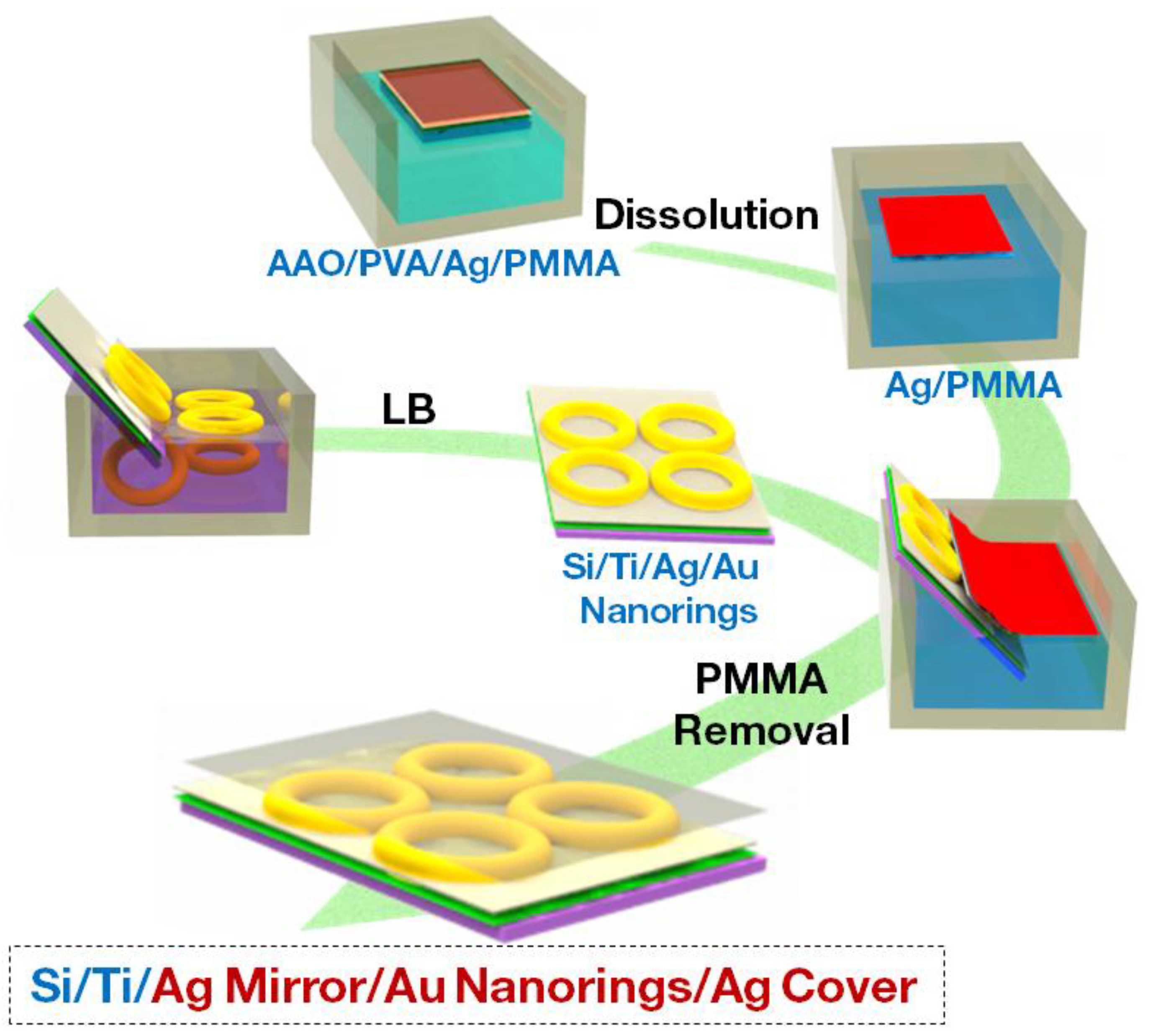
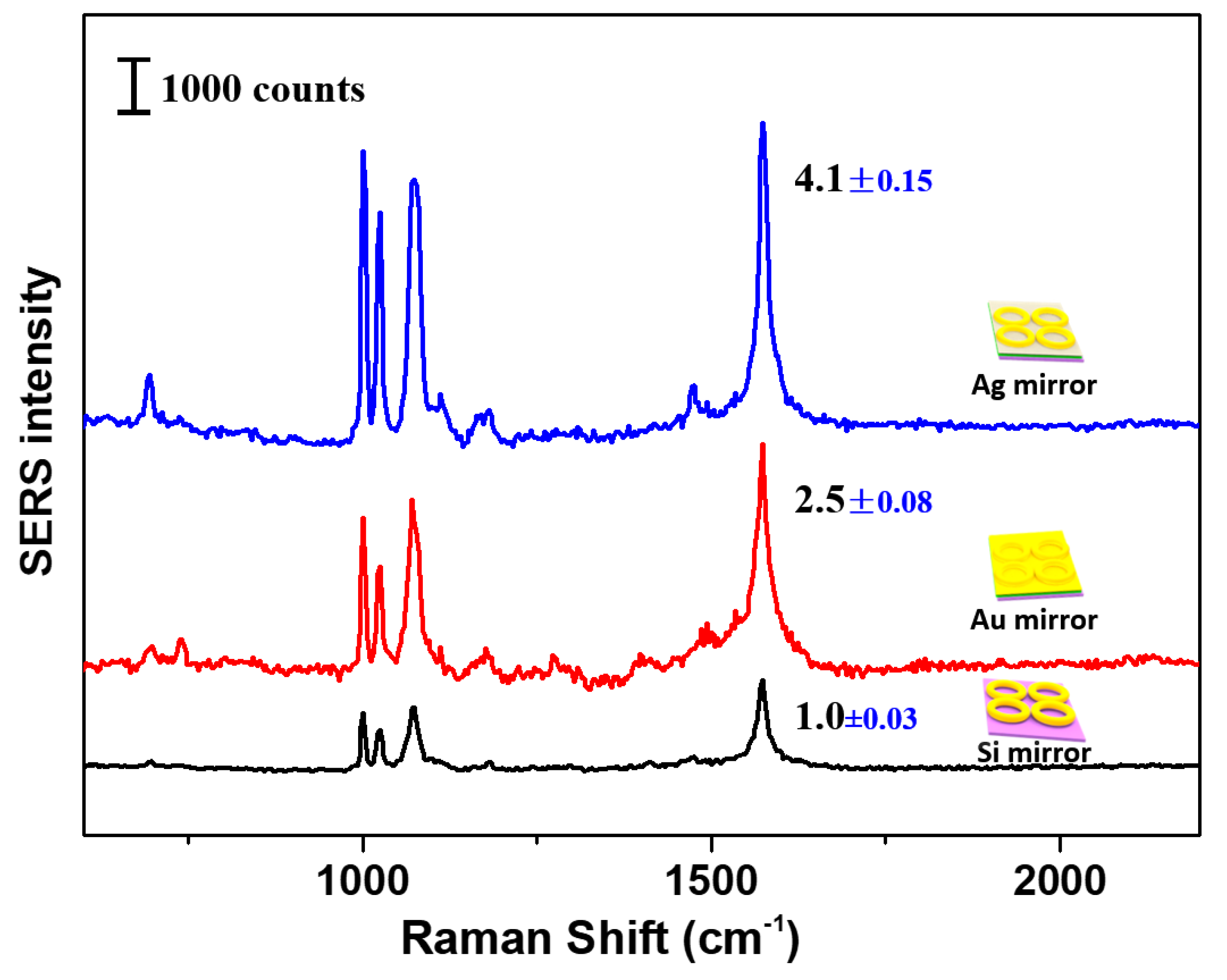
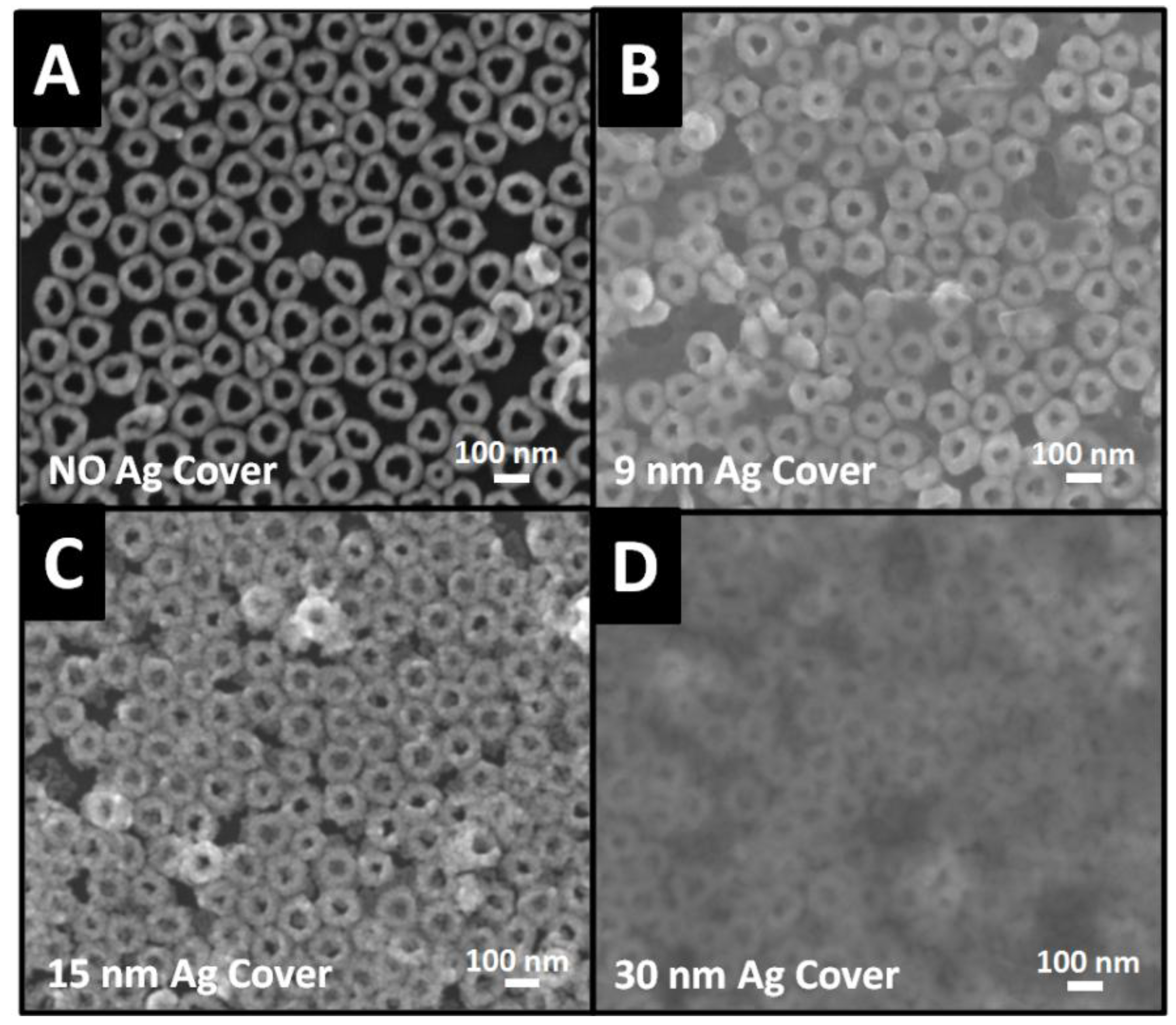
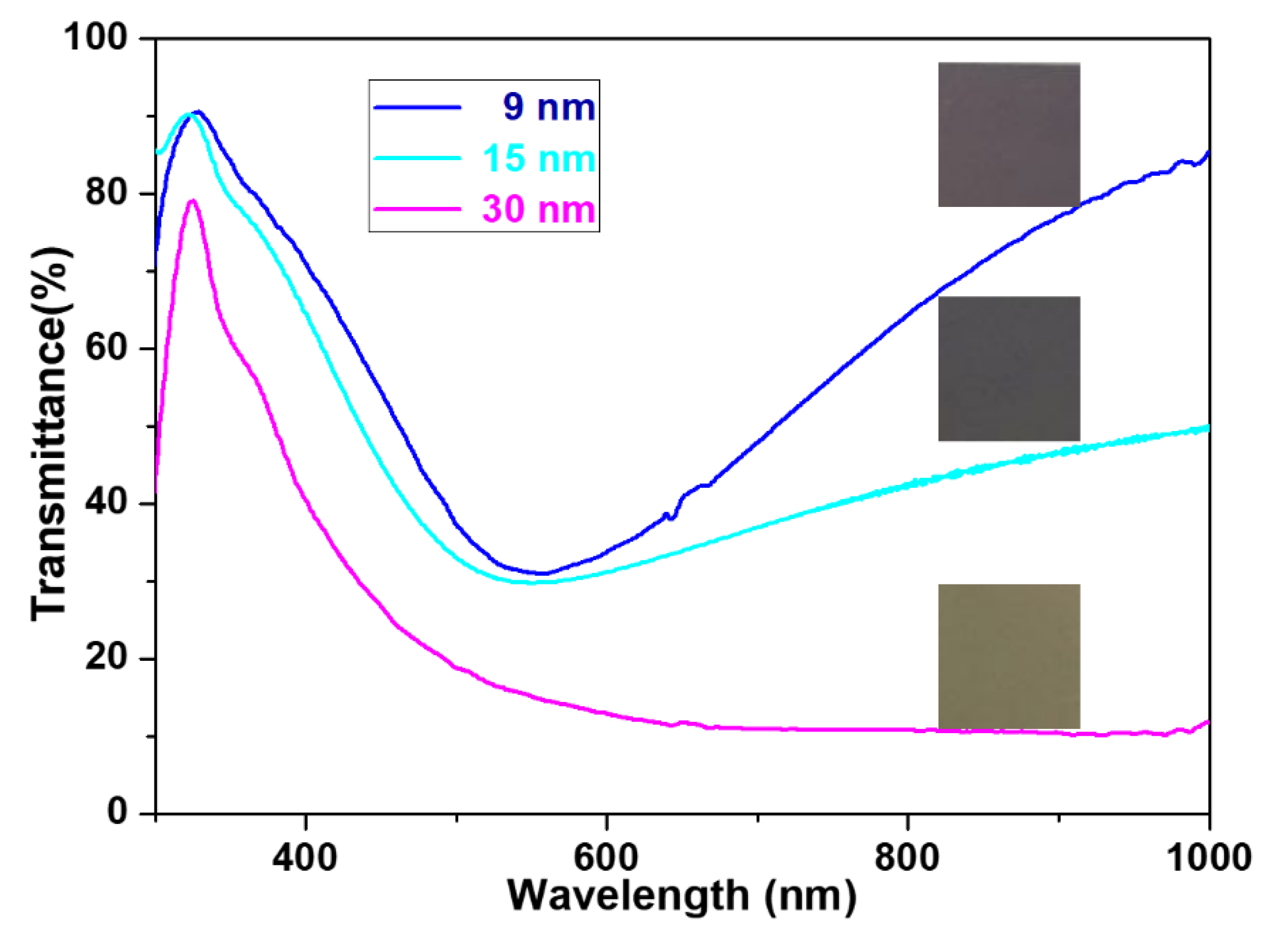
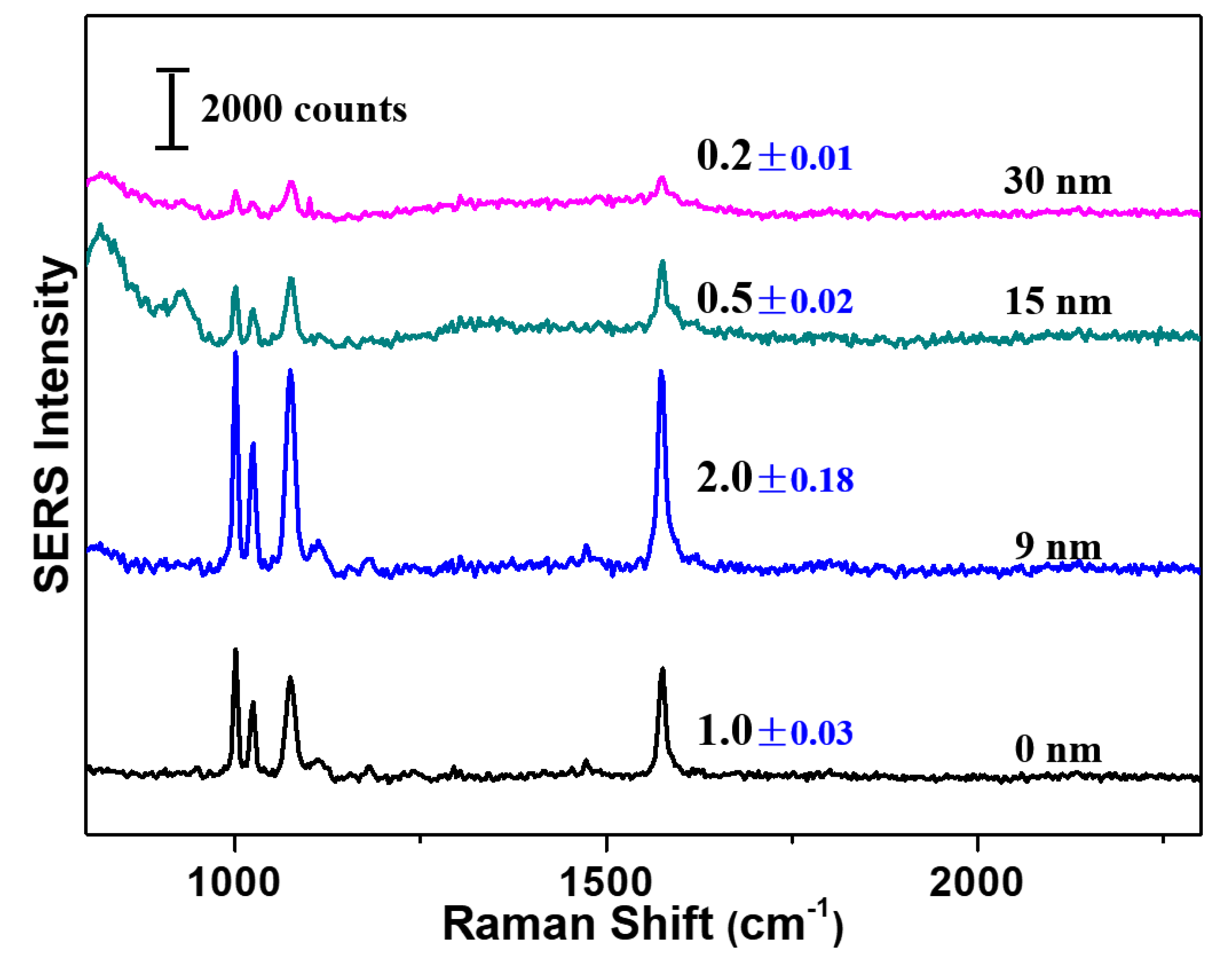
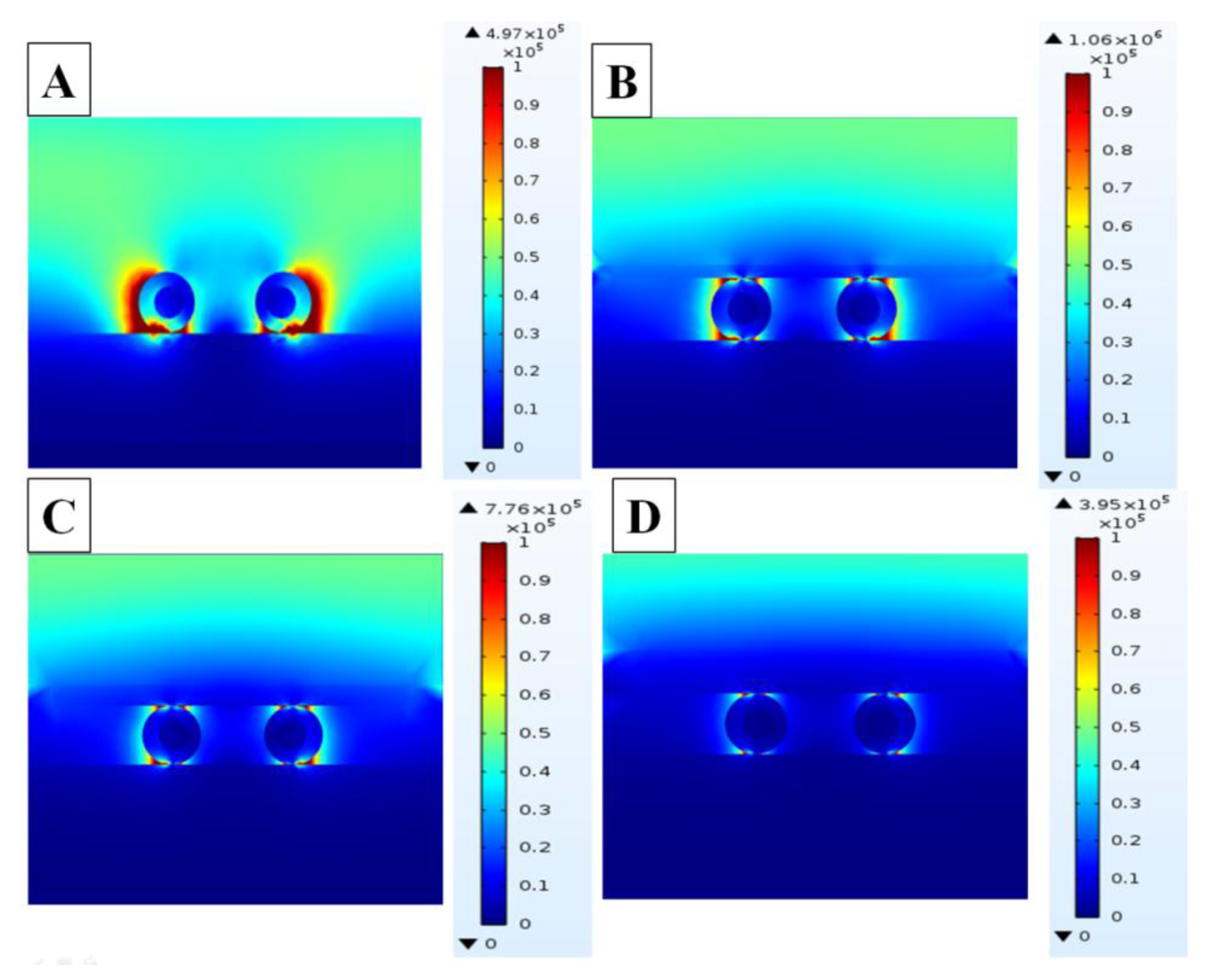
© 2020 by the authors. Licensee MDPI, Basel, Switzerland. This article is an open access article distributed under the terms and conditions of the Creative Commons Attribution (CC BY) license (http://creativecommons.org/licenses/by/4.0/).
Share and Cite
Zhang, L.; Zhu, T.; Yang, C.; Jang, H.Y.; Jang, H.-J.; Liu, L.; Park, S. Synthesis of Monolayer Gold Nanorings Sandwich Film and Its Higher Surface-Enhanced Raman Scattering Intensity. Nanomaterials 2020, 10, 519. https://doi.org/10.3390/nano10030519
Zhang L, Zhu T, Yang C, Jang HY, Jang H-J, Liu L, Park S. Synthesis of Monolayer Gold Nanorings Sandwich Film and Its Higher Surface-Enhanced Raman Scattering Intensity. Nanomaterials. 2020; 10(3):519. https://doi.org/10.3390/nano10030519
Chicago/Turabian StyleZhang, Liqiu, Tiying Zhu, Cheng Yang, Ho Young Jang, Hee-Jeong Jang, Lichun Liu, and Sungho Park. 2020. "Synthesis of Monolayer Gold Nanorings Sandwich Film and Its Higher Surface-Enhanced Raman Scattering Intensity" Nanomaterials 10, no. 3: 519. https://doi.org/10.3390/nano10030519
APA StyleZhang, L., Zhu, T., Yang, C., Jang, H. Y., Jang, H.-J., Liu, L., & Park, S. (2020). Synthesis of Monolayer Gold Nanorings Sandwich Film and Its Higher Surface-Enhanced Raman Scattering Intensity. Nanomaterials, 10(3), 519. https://doi.org/10.3390/nano10030519




